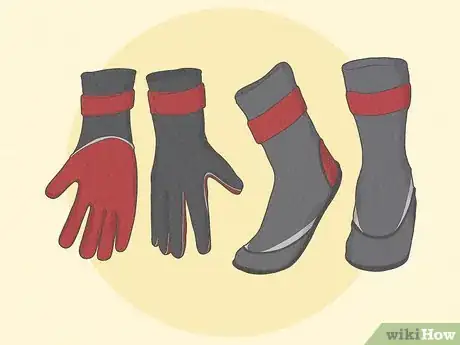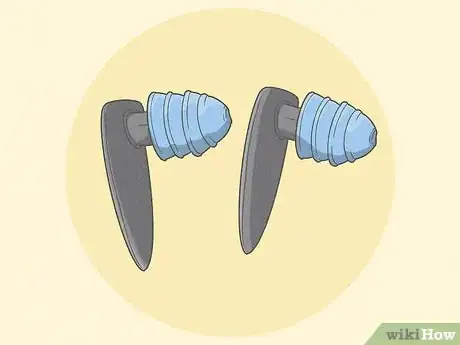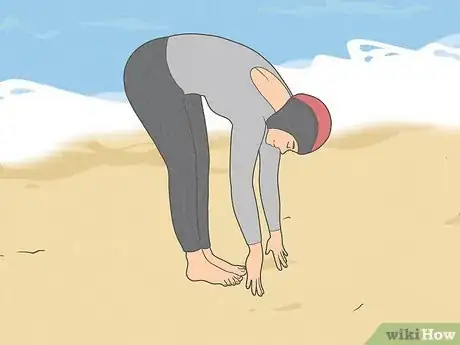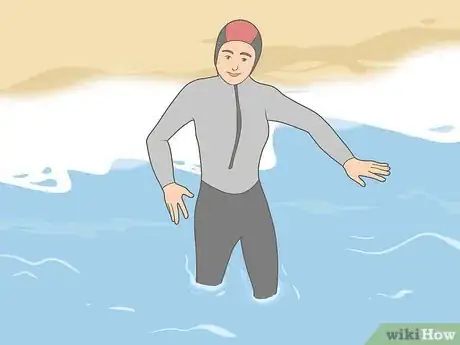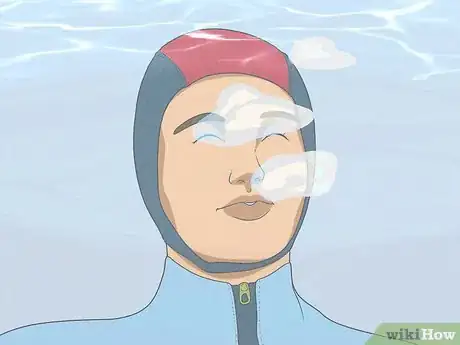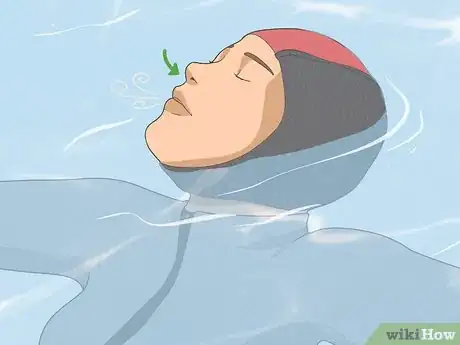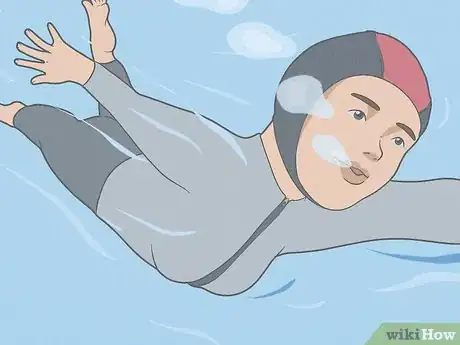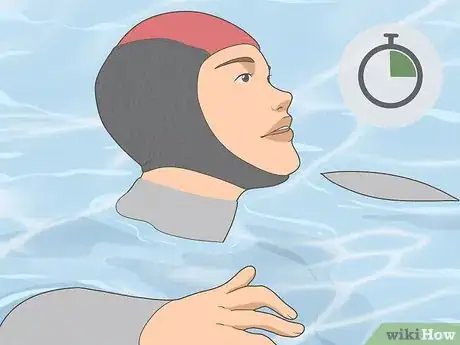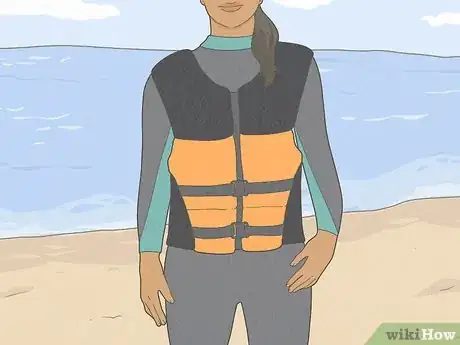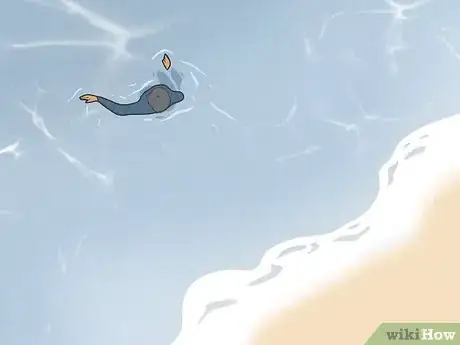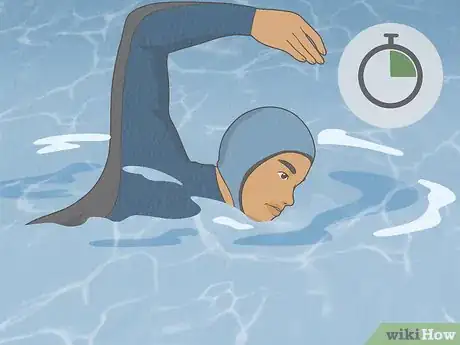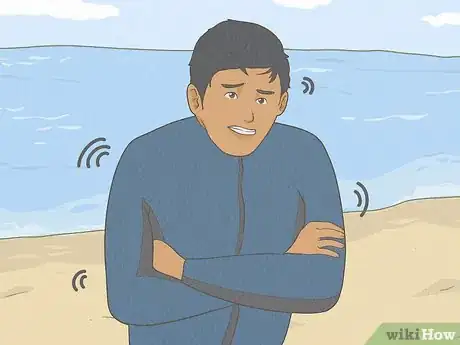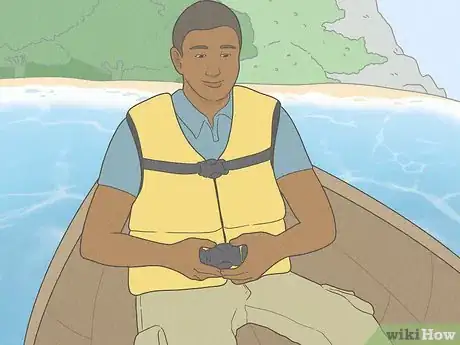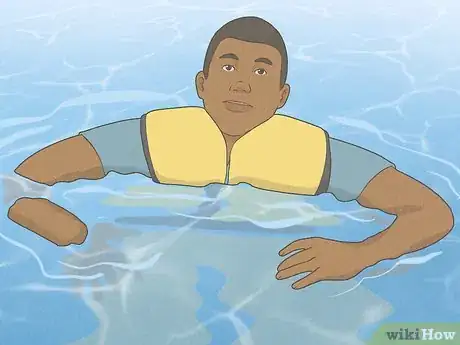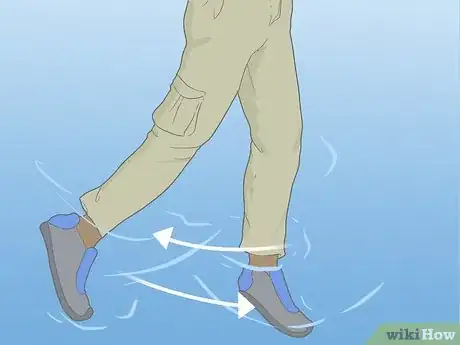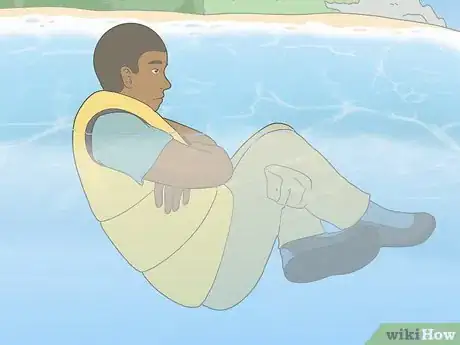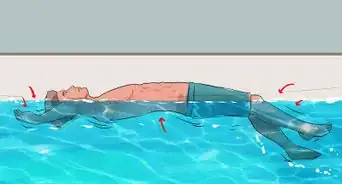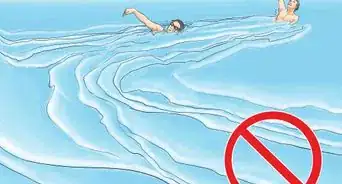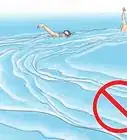This article was co-authored by wikiHow staff writer, Eric McClure. Eric McClure is an editing fellow at wikiHow where he has been editing, researching, and creating content since 2019. A former educator and poet, his work has appeared in Carcinogenic Poetry, Shot Glass Journal, Prairie Margins, and The Rusty Nail. His digital chapbook, The Internet, was also published in TL;DR Magazine. He was the winner of the Paul Carroll award for outstanding achievement in creative writing in 2014, and he was a featured reader at the Poetry Foundation’s Open Door Reading Series in 2015. Eric holds a BA in English from the University of Illinois at Chicago, and an MEd in secondary education from DePaul University.
There are 17 references cited in this article, which can be found at the bottom of the page.
This article has been viewed 86,327 times.
Learn more...
Rule number one when you take an accidental plunge into ice cold water: don't attempt to swim long distances. You'll lose too much body heat, which you need to conserve as much as possible when you're in cold water without a survival suit. You never know when your sailboat might capsize or the ice break under your feet during a fishing expedition. Read on for information on the right way to stay warm.
Steps
Dressing for Cold Water
-
1Put on a drysuit if you’re going scuba diving or spending time underwater. Buy or rent a drysuit to keep yourself as warm as possible in the water. Drysuits have a layer of thermal insulation that keep water off of your skin entirely. A drysuit is mandatory if you’re spending an extended period of time in cold water. Put on your drysuit one leg at a time, pull your arms through the sleeves, and zip yourself up. Adjust the gaskets around your neck, wrists, and ankles so that they’re comfortable and resting evenly against your skin.[1]
- When it’s fitted correctly, the drysuit should feel kind of like you have a vacuum surrounding your body. It may be uncomfortable at first, but you’ll get used to it.
-
2Opt for a wetsuit if you’re surfing, swimming, or kayaking. If you’re spending time around cold water where you may get splashed or end up temporarily wet, put on a wetsuit. A wetsuit is a skintight suit that provides some insulation against water by trapping heat in. It won’t keep you entirely dry, but you’ll be able to move around much easier than you normally would in a wetsuit.[2]
- A wetsuit is ideal if you’re going out in water that is warmer than 65–70 °F (18–21 °C). If it’s colder than this, the wetsuit won’t keep you entirely out of danger. It should still be fine if you’re only in the water for a few minutes, but it isn’t a good option for longer swims.
Advertisement -
3Wear a neoprene survival suit for activities near freezing water. If you are going camping, ice fishing, or out in freezing weather where you may end up in water, wear a survival suit. It is heavily-insulated and can keep you warm in extreme environments. Put the suit on like a snowsuit by putting your legs in one at a time, putting your arms in the sleeves, and zipping it up with the hood on.[3]
- A survival suit is not designed for swimming. However, it’s ideal if you end up falling into freezing water where you risk immediate shock from the cold water.
- Neoprene is a type of synthetic rubber that is phenomenal at capturing heat and resisting cold.
-
4Wear neoprene gloves and socks if you’re going for a cold swim. If you’re one of those adventurous people that love cold water swimming, put on some neoprene gloves, and some neoprene socks if they aren’t built into your wetsuit, drysuit, or survival suit. These garments will keep you from losing heat through your hands and feet.[4]
Warning: Cold-water swimming, which is any swimming taking place in water colder than 60 °F (16 °C), can be exhilarating. However, it is extremely dangerous. Never go cold-water swimming alone always wade in slowly to avoid cold-water shock.[5]
-
5Put on two neoprene swimming caps to keep your head warm. Get two neoprene swimming caps and put both of them on. The swimming caps should be tight enough that they don’t fall off of your head in the water, but not so tight that they’re restricting blood flow to your head. Test your caps in warm water first to make sure they don’t fall off.[6]
- A single swimming cap is fine for warm water, but you need two layers to keep your head warm in cold water.
-
6Pop in a pair of swimming earplugs to prevent swimmer’s ear. Water in the ear canal is obnoxious to begin with, but cold water in your ears is especially painful. Get some swimmer’s earplugs and put them in before taking a plunge.[7]
- You must use swimming earplugs. Standard earplugs won’t keep water out of your ears.
Swimming Efficiently in Cold Water
-
1Warm up and stretch before going into the water. Take a quick 5- to 10-minute jog, do some general toe touches and arm stretches, and do some jumping jacks to prepare your body for the water. If you go in with cold muscles and a low heart rate, you’re more likely to experience cold-water shock as you’re wading into the water.[8]
- This process applies to experienced swimmers looking to stay warm during cold water swims that take place in water colder than 70 °F (21 °C). While this is dangerous to do, it can be safe if you know what you’re doing and take the proper precautions.
-
2Wade into cold water slowly and resist the urge to dive in. There’s a common misconception that it’s better to jump into cold water to get it over with. This is fine if the water is 80 °F (27 °C) or warmer, but you may experience cold-water shock if you do this in cold water. Wade out slowly into the water and take your time acclimating to the temperature. It may be unpleasant, but it’s much better than simply jumping in.[9]
- This is a good general rule of thumb for anybody. It’s never really safe to just jump into a body of water if you aren’t already swimming or going off of a diving board in a pool.
-
3Blow bubbles as you submerge your face in the water the first time. When your face first hits the water, the cold water may trigger cold-water shock. When this happens, your lungs may contract and you may accidentally swallow water. To prevent this, exhale like you’re blowing bubbles as your face hits the water. This will keep you from swallowing water and make it much easier to control your lungs.[10]
-
4Focus on inhaling and exhaling evenly. In the cold water, your lungs may tighten up. As you’re swimming, focus on your breathing and make sure you’re inhaling and exhaling at even intervals. If you can’t control your breath, get out of the water and warm up immediately.[11]
-
5Swim continuously to keep your blood circulating and limbs warm. Your body gets colder the slower the blood runs through your veins. If you stop swimming, your heart rate will slow down and you’ll get cold as the blood slows down. To prevent this, keep swimming while you’re in the water and avoid stopping to tread water or stand on the seabed.[12]
- Swim back and forth along the shoreline—don’t swim out to open water. The closer you are to the shore, the safer you are.[13]
-
6Build your tolerance up over time to improve your cold-water swimming skills. If you’re new to cold-water swimming, limit yourself to 10- to 15-minute swims. Work your way up slowly over time before progressing to longer swims. The same goes for temperatures. Start out with 60–70 °F (16–21 °C) swims and work your way up (or down) to those polar plunges over time.[14]
- It can take months of practice to get used to swimming in cold water. Try not to get frustrated and take short swims regularly to build your tolerance up.
Staying Safe as a Swimmer
-
1Bring a lifejacket with you if you’re going anywhere near water. If you’re getting on a boat, doing some shore fishing, or heading out to the beach, bring a lifejacket. Nature can be unpredictable and it’s hard to know when you’ll need it, but a lifejacket will seriously improve your odds of survival if you go overboard or end up in the water.[15]
- To put a lifejacket on, slide the vest over your head and clip the straps around your waist and shoulders. The lifejacket should be fit snugly to your chest.
- Depending on where you live, it may be illegal to go boating without a lifejacket.[16]
-
2Check the water temperature before going for a swim. If the water is calling your name but it feels or looks a little cold, look the temperature up online. Water temperatures are published alongside regular weather reports and they’re easy to find. If the water is warmer than 80 °F (27 °C), feel free to take a dip. If it’s between 70–80 °F (21–27 °C), put a drysuit or wetsuit on before going in the water if you aren’t an experienced swimmer.[17]
- You can wear a wetsuit or drysuit if you’re swimming in water warmer than 80 °F (27 °C), but your body should be fine so long as you’re just going for a casual dip.
- At 80 °F (27 °C), the water may sound pleasant and warm. For most people, this is actually quite cold! The body processes temperature changes from air and water differently, so even slightly colder water can feel freezing.
-
3Do not go swimming if the water is colder than 70 °F (21 °C). Cold-water shock occurs in water colder than 70 °F (21 °C). As a result, it is not safe to go into water colder than this without special equipment, supervision, and experience. If you are swimming in water below this threshold in a drysuit or wetsuit, do not jump directly into the water. Instead, wade out slowly.[18]
- Cold-water shock is the human body’s response to being suddenly submerged in cold water. Your muscles will instantly retract and you could stop breathing.[19]
- You can swim in water colder than 70 °F (21 °C) if you’re wearing a wetsuit or drysuit, but only if the combined air and water temperature is at least 120 (in Fahrenheit). For example, if the water is 50 °F (10 °C) and it’s 75 °F (24 °C) outside, you should be fine to take a short dip with a wetsuit or drysuit.[20]
-
4Go into the water when you're warm and warm up slowly when you get out. Do not get changed outside, don’t go in the water if you’re drying out from a previous dip, and never go into water if you already feel cold. When you get out, warm up slowly with a thermal blanket and a warm drink after drying off. If you were wearing normal clothes, take them off when you get out of the water.[21]
- Drysuits and wetsuits are designed to wick water, so you can normally warm up without changing. If you feel cold though and your clothing is keeping you from warming up, change.
-
5Swim as close to the shore as possible and never swim in open water. If you’re on an anchored boat and thinking about swimming in some cold water, don’t do it. It may be too hard to climb the ladder or get rescued if you go into cold-water shock. When swimming in a lake or at the beach, stay as close to the shore as possible. You need to get back on solid ground as fast as possible if anything goes wrong.[22]
- Never go swimming alone. If you’re debating a swim in chilly water but there isn’t anyone around, don’t do it. If you experience cold-water shock, you won’t be able to get yourself out of the water.
-
6Limit the amount of time you stay in cold water. Keep your swim as short as you can to avoid dangerous situations or hypothermia. Unless you’re experienced with cold water swimming, limit yourself to a 10- to 15-minute dip.[23]
- If you’re swimming in a lake or ocean, stay as close as you can to the shoreline in case you need to get back quickly.
-
7Get out if you start shivering uncontrollably or your heart rate jumps. Shivering for a minute or so as you’re getting in is fine, but if you keep shaking and your teeth won’t stop chattering, get out of the water. Similarly, if it starts to feel like your heart is pumping hard, it’s time to get out. These are the early signs of hypothermia, a dangerous condition where the body starts losing heat faster than it can produce it.[24]
- If you start to experience hypothermia, warm up as quickly as you can and call emergency services. You’ll need a medical checkup after you warm up to ensure that your organs are working correctly.
Other Signs of Hypothermia:
Nausea
Confusion
Dizziness
Shallow breathing
Slurred speech
Clumsiness or difficulty moving
Surviving in Cold Water after an Accident
-
1Put on a lifejacket if you can access one. If something goes wrong and you end up in an emergency situation on a boat or plane, find a lifejacket immediately. Put it on and tighten the straps around your waist and chest so that lifejacket hugs your torso firmly.[25]
- It's hard to stay warm if you’re swimming to stay afloat since it requires so much energy and heat, so putting a lifejacket on is essential.
- When you get on to a boat or plane, pay attention to the emergency preparation speech at the beginning of the trip. The flight attendant or ship’s mate always tells you where the lifejackets are.
-
2Stay where you are unless you’re close to a shore or floating debris. If you think you’re within 1 mi (1.6 km) of the shore and there’s nobody around to help, swimming for the shore is likely the best option. Otherwise, look for a piece of debris to grab on to and stop swimming. Swimming requires energy, which expels heat. While that may warm you up in the short term, you’re going to start freezing much faster than if you just float or tread water.[26]
- In 50 °F (10 °C) water, the average adult will survive for roughly 2 hours if they swim. If they stay still, they’ll survive for roughly 3 hours. This is a big difference if you’re waiting to be rescued or holding out for help![27]
- In freezing water (32.5–40 °F (0.3–4.4 °C)), the average adult has roughly 15–30 minutes before they loose consciousness. It’s extremely important that you do not waste energy or heat by swimming randomly if there isn’t a shore or floating debris nearby.[28]
-
3Keep your head above water by holding onto something, if possible. If you’re holding on to something in the water or you’re floating with your lifejacket on, do everything you can to keep your head out of the water. If you’re holding on to an object to help you float, pull as much of yourself up as possible.[29]
- This will preserve heat and keep you from drowning.
- The body has an easier time insulating itself in cold air than cool water.
-
4Tread water to keep your head up if you can’t hold anything. For cold water, the flutter kick is your best bet. Let your arms float on the surface and point your toes down. Then, kick your legs back and forth in short bursts while keeping your legs straight. Increase the kicking speed as needed to keep your head out of the water.[30]
- You’d be surprised how long you can tread water, especially in an emergency. The average adult can tread water for 2–3 hours, but you can last even longer if you’re athletic.[31] The time you’ll last drops dramatically the colder it gets, but if your choice is treading water or swimming randomly, treading is the better option.
-
5Adopt the HELP position if you’re floating with a lifejacket on. The Heat Escape Lessening Position, also known as the HELP position, keeps your body as warm as possible and conserves energy while you wait to be rescued. Draw your legs up to your chest and cross your feet. Wrap your arms around your chest and curl up as best as you can. Sit in the water with your knees facing up and bob in the water. This will keep you from losing heat quickly.[32]
- In 50 °F (10 °C) water, the average adult will survive for roughly 4 hours in the HELP position. This is twice as long as you’d normally last by just floating freely or treading water.
Variation: This only works if you’re wearing a lifejacket, but you can do a version of this if you’re holding on to something in the water. Just open your hands and grip the edge of the debris, wood, or object, and slide your knees up underneath it to tuck them close to your body.
-
6Huddle together with others if you can to preserve your heat. If you're in the water with other people, the best way to stay warm is to huddle together. Get close to each other and lock arms and legs so that you're forming a big group hug. Make as much bodily contact with each other as you can.[33]
- This is more beneficial than the HELP position, but it only works if everyone can stay linked.
-
7Get warm as soon as you get out of the water and get help. Once you’re rescued or get on your feet, slowly remove the wet clothing and cover yourself in dry blankets or clothes. Stay out of the wind and warm up as quickly as you can with a warm drink, warm water, or a warm compress. Focus on slowing your breathing and wait to warm up.[34]
- If you get out of the water but don’t have any dry blankets or clothes, cover yourself in any dry material laying around that can insulate you. Get help as soon as you possibly can.
Community Q&A
-
QuestionWhat happens if the water below is freezing, and there is no boat in reach? The odds of surviving are slim in this situation, an example is the Titanic.
 Community AnswerWithin approx. 0.5-1 hours, you will most likely die from hypothermia. The same happened on Titanic.
Community AnswerWithin approx. 0.5-1 hours, you will most likely die from hypothermia. The same happened on Titanic. -
QuestionIs it safe to swim for an hour in water that is 20 degrees Celsius?
 Community AnswerYes, that is perfectly fine, but make sure you are warm afterward or you might get sick.
Community AnswerYes, that is perfectly fine, but make sure you are warm afterward or you might get sick. -
QuestionDoesn't moving around in the water warm a person up?
 FarisCommunity AnswerYes, that is true. When you stay in the cold water and swim in it for several minutes, you will get used to it. If the weather is cold, clubs will usually warm up the water.
FarisCommunity AnswerYes, that is true. When you stay in the cold water and swim in it for several minutes, you will get used to it. If the weather is cold, clubs will usually warm up the water.
Warnings
- Never go swimming in water colder than 70 °F (21 °C). Even if you think you can handle it, it’s simply not worth the risk.[35]⧼thumbs_response⧽
References
- ↑ http://news.mit.edu/2018/artificial-blubber-protects-divers-frigid-water-0619
- ↑ https://divediscover.whoi.edu/archives/expedition10/hottopics/colddiving.html
- ↑ https://youtu.be/A_6n5Dp1UdI?t=39
- ↑ https://youtu.be/wptKtR3LGZU?t=117
- ↑ https://www.cnn.com/2017/05/03/health/ice-swimming-health-benefits-and-dangers/index.html
- ↑ https://youtu.be/wptKtR3LGZU?t=117
- ↑ https://www.independent.co.uk/extras/indybest/outdoor-activity/swimming/best-earplugs-swimming-adults-review-pool-a8452951.html
- ↑ https://www.active.com/fitness/articles/8-ways-to-handle-swimming-in-cold-water
- ↑ https://www.hss.edu/playbook/swimming-in-cold-weather-conditions/
- ↑ https://www.active.com/fitness/articles/8-ways-to-handle-swimming-in-cold-water
- ↑ https://www.breathemagazine.com/2018/06/07/cold-water-swimming/
- ↑ https://outdoorswimmer.com/blogs/6-tips-for-cold-water-swimming
- ↑ https://www.breathemagazine.com/2018/06/07/cold-water-swimming/
- ↑ https://outdoorswimmer.com/blogs/6-tips-for-cold-water-swimming
- ↑ https://coastguard.dodlive.mil/2012/03/how-long-can-you-tread-water/
- ↑ https://dnr.wi.gov/topic/boat/pfd.html
- ↑ https://www.hss.edu/playbook/swimming-in-cold-weather-conditions/
- ↑ https://www.hss.edu/playbook/swimming-in-cold-weather-conditions/
- ↑ https://www.steroplast.co.uk/content/cold-water-shock/
- ↑ https://www.gobair.org/Resources/Documents/Cold_Water.pdf
- ↑ https://youtu.be/wptKtR3LGZU?t=371
- ↑ https://www.redcross.org/get-help/how-to-prepare-for-emergencies/types-of-emergencies/water-safety/beach-safety.html
- ↑ https://youtu.be/wptKtR3LGZU?t=371
- ↑ https://www.hss.edu/playbook/swimming-in-cold-weather-conditions/
- ↑ https://coastguard.dodlive.mil/2012/03/how-long-can-you-tread-water/
- ↑ http://www.seagrant.umn.edu/coastal_communities/hypothermia#true
- ↑ http://www.seagrant.umn.edu/coastal_communities/hypothermia#true
- ↑ http://www.seagrant.umn.edu/coastal_communities/hypothermia#true
- ↑ http://www.seagrant.umn.edu/coastal_communities/hypothermia#true
- ↑ http://www.seagrant.umn.edu/coastal_communities/hypothermia#true
- ↑ https://coastguard.dodlive.mil/2012/03/how-long-can-you-tread-water/
- ↑ http://www.seagrant.umn.edu/coastal_communities/hypothermia#true
- ↑ http://www.seagrant.umn.edu/coastal_communities/hypothermia#true
- ↑ http://www.seagrant.umn.edu/coastal_communities/hypothermia#true
- ↑ https://www.hss.edu/playbook/swimming-in-cold-weather-conditions/



